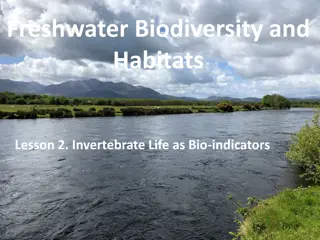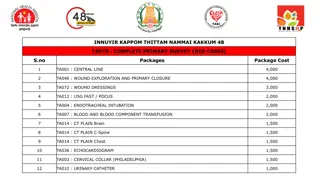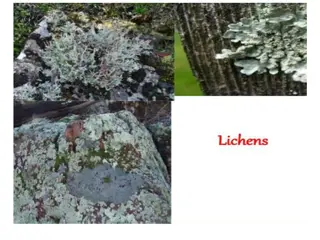Understanding Batrachospermum: A Freshwater Red Alga
Batrachospermum, a red alga commonly found in freshwater habitats like streams, ponds, and lakes, is characterized by its beautiful, gelatinous thallus structure. The plant body grows up to 15-20 cm and exhibits varying colors based on light exposure. Its thallus is differentiated into prostrate and erect systems, with distinct branching patterns. Each cell contains red chromatophores and reserve food in the form of Floridean starch. This unique alga plays a vital role in aquatic ecosystems.
Download Presentation

Please find below an Image/Link to download the presentation.
The content on the website is provided AS IS for your information and personal use only. It may not be sold, licensed, or shared on other websites without obtaining consent from the author. Download presentation by click this link. If you encounter any issues during the download, it is possible that the publisher has removed the file from their server.
E N D
Presentation Transcript
Batrachospermum (Frog spawn) Systematic Position Division- Rhodophyta Class- Rhodophyceae Order- Nemalionales Family- Batrachospermaceae Genus- Batrachospermum Occurrence- - It is a fresh water, red alga - Found in cold water of streams, ponds, lakes - B. moniliforme is the most common species
Thallus structure Plant body is beautiful, branched, multicellular, soft and gelatinous It grows up to 15-20 cm. and bluish-green, violet or red in colour Colour of thallus depends on the intensity of light available Thallus growing in deep & shady places are violet or dark-red Those growing in shallow & illuminated places are bluish-green in colour Mature thallus appears as a chain of beads Thallus is differentiated into a prostrate and an erect system Prostrate branches anchor the thallus to the substratum Erect branches float freely in water Main/Primary axis is uniseriate having large cylindrical cells It is differentiated into nodes and internodes From the node of main axis develop two types of branches Branches of unlimited growth & branches of limited growth
From each node of the main axis as well as of the branches of unlimited growth develop many dwarf branches or branches of limited growth Branches of limited growth on a node have more or less the same length They all together form a small globose mass Because of the presence of such globose masses on each node, the entire thallus appears as a red beaded structure Such a beautiful clusture of branches of limited growth on a node is called Glomerule Each branch of limited growth is further branched or unbranched It consists of small, moniliform/ellipsoidal, uninucleate cells Long, narrow corticating threads form of sheath around the internode represent the cortex
Cell structure Each cell is large, cylindrical and surrounded by a cell wall Outer wall- pectic and Inner wall- cellulosic It contains several, discoid, red chromatophores which are parietal in position Pigments Chlo -a, Chlo -d, r Phycocyanine and r Phycoerythrin (excess) Chromatophores contains a single pyrenoid Cell is uninucleate Golgi bodies and mitochondria are also present Reserve food Floridean starch
Reproduction- takes place by asexual and sexual methods. I] Sexual reproduction- Oogamous type while species are monoecious or dioecious Male reproductive structure - Spermatangium Female reproductive structure - Carpogonium Development of Spermatangium- Develop on the branches of limited growth Terminal/subterminal cell functions as Spermatangial mother cell It develops 3-5 spermatangia in the form of projections(outgrowths) Mature spermatangium- unicellular,uninucleate,hyaline,spherical structure This 3 layered structure soon cuts off with a septum The contents inside the spermatangium metamorphoses into single, non- flagellate, rounded, colourless male gamete- spermatium Liberation Thin walled spermatia are liberated through apical aperture
Development of Carpogonium- Develop on special lateral female/ carpogonial branch This branch is developed by repeated transverse divisions of basal cells It is short, 3-5 celled branch Terminal cell converts into a flask shaped carpogonium Sub terminal cell below the carpogonium hypogynous cell / supporting cell Mature Carpogonium Flask shaped structure with basal swollen part /egg cell contains single egg Terminal long neck like Trichogyne (to receive male gamete) It may be slipper shaped, club shaped, cylindrical, spatula shaped etc.
Fertilization Takes place with the help of water Non motile spermatia comes in contact with trichogyne On mucilagenous part of trichogyne spermatia sticks on it Wall between them dissolves & male nucleus enters into the trichogyne It fuses with female egg nucleus and forms diploid zygote Post fertilization changes Diploid zygotic nucleus divides reductionly, resulting into 4 haploid nuclei They again divide to form many haploid nuclei Many small outgrowths develop from the basal part of carpogonium called as gonimoblast initial Gonimoblast initials divide transversely to form gonimoblast filaments
They may be branched or unbranched and form a sort of cluster around it Uppermost cell of gonimoblast filament becomes swollen and functions as a carposporangium Contents of carposporangium develops into haploid, uninucleate carpospore Lower cells of gonimoblast filaments give rise to many sterile filaments They form protective envelope around the carpospores This composite structure of carpospores, gonimoblast filaments along with sterile filaments is known as cystocarp or carposporophyte Carpospores are liberated by the rupture of mature carposporangium Germination of carpospores- Carpospore settles on substratum and germinates by giving out tubular structure The tubular outgrowth divides transversely many times to form creeping filament which may form prostate system
From prostate system develop many erect filaments Thus develops a heterotrichous structure At this stage Batrachospermum resembles another alga Chantransia This heterotrichous stage is called as Chantransia stage This represents the juvenile stage of Batrachospermum Asexual reproduction- From lateral branches of Chantransia stage develop swollen structures called monosporangia Monosporangium develops single monospore which is uninucleate, non-motile and haploid Each monospore germinates and again produces Chantransia stage Some erect filaments separates and behave as independent plant























